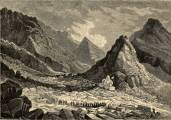


Missouri Building and Ornamental Stones - 1886
Excerpt from
Report of the United States National Museum
Under the Direction of the Smithsonian Institutions
For the Year Ending June 30, 1886,
Chapter entitled
“The Collection of Building and Ornamental Stones In The U. S. National Museum:
A Hand-book and Catalogue”
By George P. Merrill, Curator, Department Lithology and Physical Geology.
“Limestones and Dolomites. Marbles,” pp. 379-380.
“Missouri. - We have seen but few true marbles from this State, though colored marbles of fine quality equaling the variegated varieties of Tennessee are reported by Professor Broadhead as occurring in Iron, Madison, and Cape Girardeau Counties. The Iron County stone is reported as light drab in color, with buff veins. The outcrop occupies an exposure of several hundred feet of a low bluff on Marble Creek near the east line adjoining Madison County. The Madison County marble occurs near Fredericktown, and is described as the best-appearing marble in the State both in regard to color and texture, the colors being red, peach-blossom, and greenish, beautifully blended. The stone is represented as very durable, but liable to tarnish on a polished surface when exposed to the weather. The Cape Girardeau stone is represented as of a variety of colors - purple, yellow, red, pink, gray, and greenish all being enumerated; the supply is unlimited. None of these marbles are at present systematically worked, owing to lack of capital and distance from market. Professor Broadhead further states that few of the marble beds of southeastern Missouri are thick enough to be economically worked, as there would be too large a portion of waste material.
“No pure white crystalline marbles are as yet known to occur within the State limits. Other stones capable of receiving a polish and suitable for marble are stated to occur in the counties of Saint Louis, Saint Charles, Warren, Montgomery, Ralls, Calloway, Lincoln, Cooper, Pettis, Cass, Jackson, Livingston, and Clay.”
“Limestones and Dolomites Other Than Marbles” in Missouri, pp. 402.
“Missouri. - Limestones and dolomites of a nature unfitted for marbles, but of good quality for general building purposes, occur in great abundance in Saint Louis, Cole, Cooper, Pettis, and Jackson Counties in this State. At present, owing to the ready accessibility of a good market, the Saint Louis stone is the most extensively quarried of any of these mentioned. The stone, which is of Carboniferous age, is fine-grained and compact, and of a drab color. It is represented as strong and durable and well adapted for the manufacture of lime. at present it is used largely for foundations. A very fine-grained and compact limestone of a dark drab color occurs near Saverton, in Ralls County, which has been used to some extent for lithographic purposes. Stones from other localities are mostly compact, and of light or dull red. A very light encrinital stone is quarried in the vicinity of Hamilton and Bear Creek, in Marion County.”
Granites in Missouri, pp. 422.
“Missouri. - Although there are inexhaustible quantities of granite in the northern part of Iron and Madison Counties the southern portion of Saint Francois, there are but few quarries of the material systematically worked.
“At Graniteville, Iron County, and in Syenite, Saint Francois County, there occurs a coarse red granite, quite poor in mica, which is now extensively quarried for the Saint Louis and Chicago markets. It is somewhat lighter in color than the well known Scotch granite, but is admirably suited for massive structural purposes, as is well illustrated in the lower stories of the fine business blocks erected during the season of 1886 on Adams street, between Fifth avenue and Franklin, and on the corner of Adams and La Salle streets, in Chicago. The enormous blocks of rock-faced granite and large polished columns of this stone are here displayed* would indicate that this is destined to be one of the leading granites of this portion of the country. It admits of a high lustrous polish and is coming into use for monument work.”
(* Page 422 footnote: The window-sills in the first of the above-mentioned buildings are rough blocks of granite, each 3 feet square by 17 feet 4 inches long, and weighing about 10 tons each. The polished columns of the building corner of Adams and La Salle streets are ten in number, each 18 feet high by 4 ½ feet in diameter, and weighing not far from 18 tons. The largest single block of polished granite yet produced at these works is the Allen monument, in Saint Louis, which is 42 feet in height by 4 ½ feet square at the base. The weight is about 45 tons.)
Sandstones in Missouri, pp. 452.
“Missouri. - So far as the author has had opportunity of examining, the fine light buff subcarboniferous sandstone quarried within a few miles of the town of Saint Genevieve is the most important sandstone in the State.
“The quarry face shows a bed 25 feet in thickness of good uniform rock, and blocks 150 feet long, 20 feet wide, and 10 feet thick are said to be obtainable if desired. The stone weathers well in the climate of Saint Louis, but is stated to discolor by smoke.
“Near Miami Station, in Carroll County, a fine gray sandstone is quarried, the better grades of which make good building material; but it must be selected with care, as it frequently contains concretionary masses which weather out on exposure.
“The Johnson County sandstone is stated to be of good quality in certain situations. It has been used in several important structures in the State, and stands the test of time without scaling, only becoming stained and darkened with age. It is quite light, weighing only 140 pounds per cubic foot when seasoned, or 145-150 when freshly quarried.”
Commercial use of material within this site is strictly prohibited. It is not to be captured, reworked, and placed inside another web site ©. All rights reserved. Peggy B. and George (Pat) Perazzo.